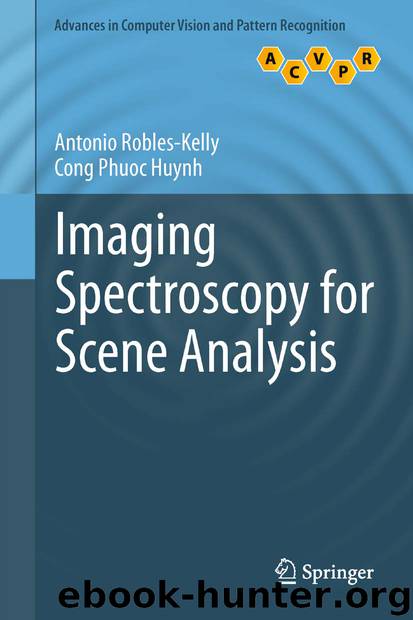Imaging Spectroscopy for Scene Analysis by Antonio Robles-Kelly & Cong Phuoc Huynh

Author:Antonio Robles-Kelly & Cong Phuoc Huynh
Language: eng
Format: epub
Publisher: Springer London, London
The uni-modal segmentation algorithm can recover the full extent of the absorption feature. Nonetheless, it may fail to perform well in cases where the continuum is not convex-shaped. Examples of this are the results on Eucalyptus leaf powder shown in Fig. 7.22. Furthermore, the uni-modal assumption on the absorption features may hold for mixed absorptions, as in the case of the Navel leaf spectra shown in Fig. 7.22. Here, the two absorption features, one shallow segment around 600 nm and the deep band around 670 nm, were mistakenly detected as a single absorption by the uni-modal segmentation algorithm. The reason is that the absorption around 670 nm is too strong and it makes the shallow band less prominent. As a result, their mixture forms only one peak after continuum removal and cannot be separated simply based on the uni-modal constraint. From our comparison results, we can assert that there is no single method which consistently give optimal results for all the spectra in the datasets. In our experience, the uni-modal segmentation algorithm performs better for the mineral spectra in the USGS spectral library. This is due to the fact that, for mineral spectral data, the cusps and valleys in the spectra are more obvious. For organic material, like plants and leaves, whose absorption features are “shallow”, the MMWT is, in general, a good option.
Download
This site does not store any files on its server. We only index and link to content provided by other sites. Please contact the content providers to delete copyright contents if any and email us, we'll remove relevant links or contents immediately.
Algorithms of the Intelligent Web by Haralambos Marmanis;Dmitry Babenko(8522)
Test-Driven Development with Java by Alan Mellor(7427)
Data Augmentation with Python by Duc Haba(7317)
Principles of Data Fabric by Sonia Mezzetta(7065)
Learn Blender Simulations the Right Way by Stephen Pearson(7006)
Microservices with Spring Boot 3 and Spring Cloud by Magnus Larsson(6825)
RPA Solution Architect's Handbook by Sachin Sahgal(6234)
Hadoop in Practice by Alex Holmes(6032)
The Infinite Retina by Robert Scoble Irena Cronin(5935)
Jquery UI in Action : Master the concepts Of Jquery UI: A Step By Step Approach by ANMOL GOYAL(5873)
Big Data Analysis with Python by Ivan Marin(5732)
Life 3.0: Being Human in the Age of Artificial Intelligence by Tegmark Max(5405)
Pretrain Vision and Large Language Models in Python by Emily Webber(4693)
Infrastructure as Code for Beginners by Russ McKendrick(4471)
WordPress Plugin Development Cookbook by Yannick Lefebvre(4204)
Functional Programming in JavaScript by Mantyla Dan(4124)
The Age of Surveillance Capitalism by Shoshana Zuboff(4118)
Embracing Microservices Design by Ovais Mehboob Ahmed Khan Nabil Siddiqui and Timothy Oleson(3995)
Applied Machine Learning for Healthcare and Life Sciences Using AWS by Ujjwal Ratan(3972)
